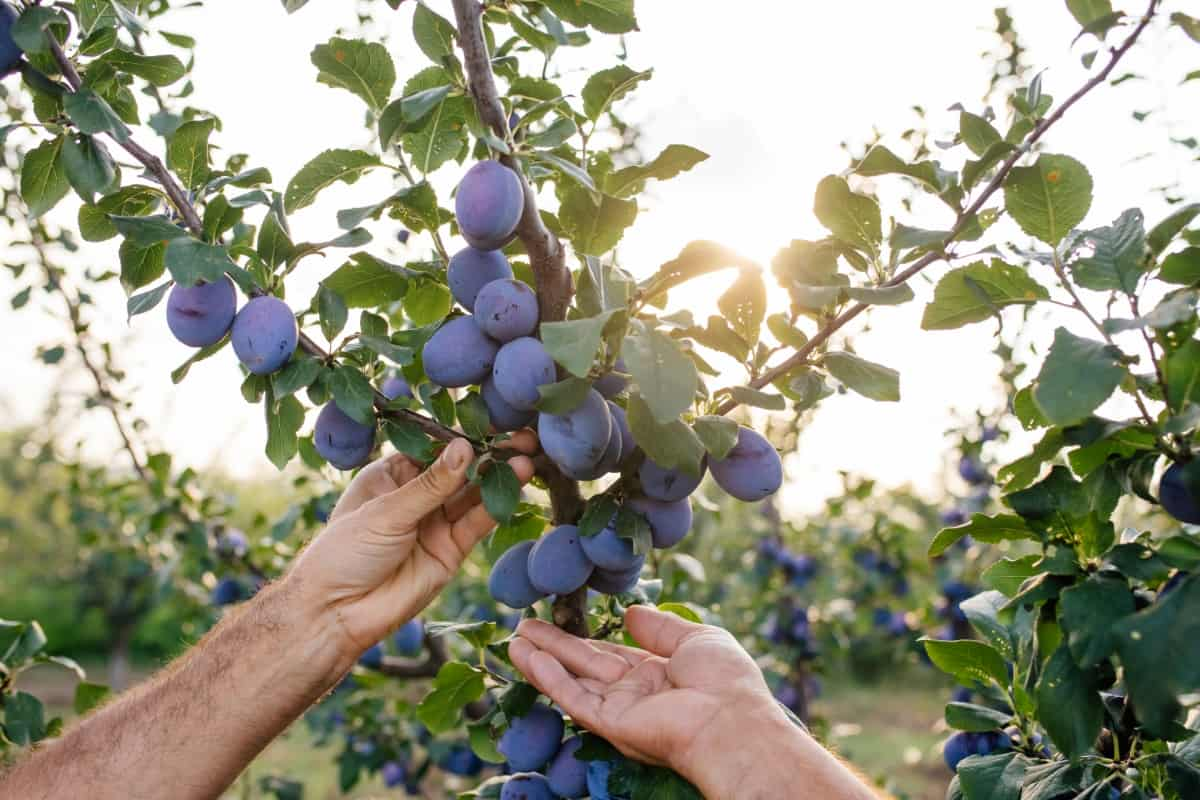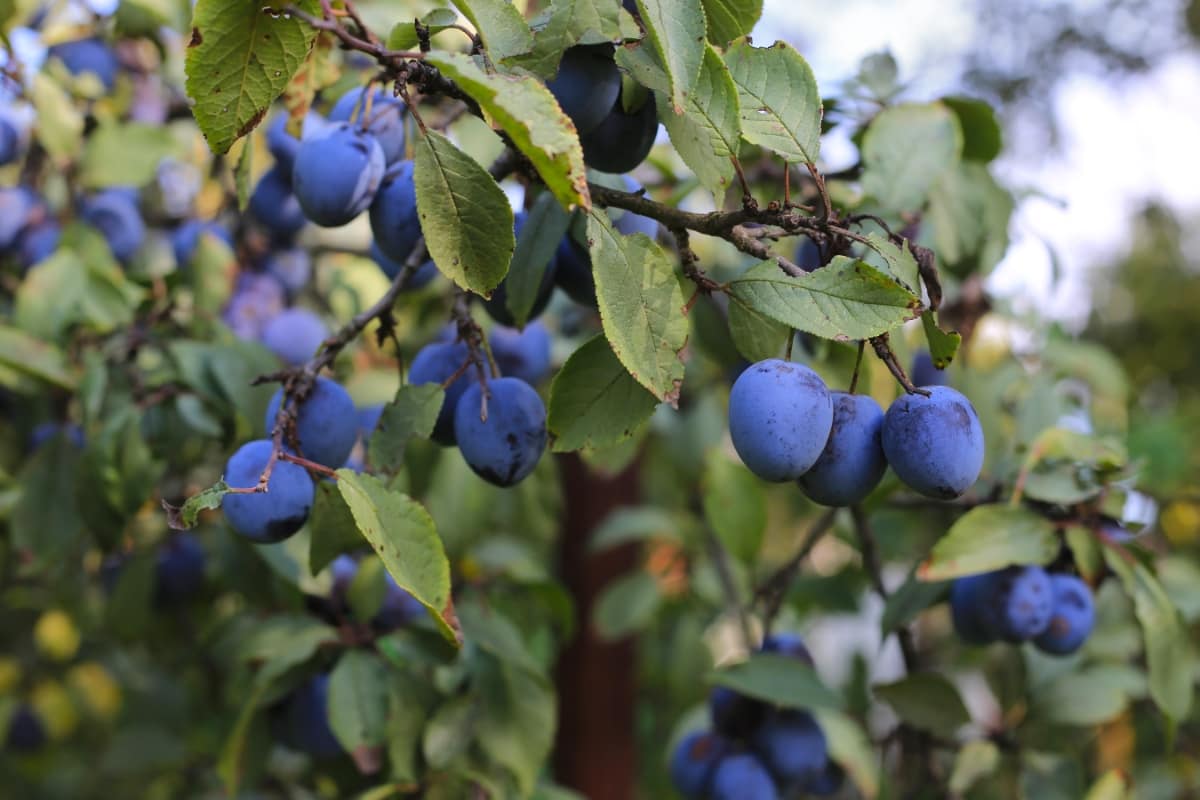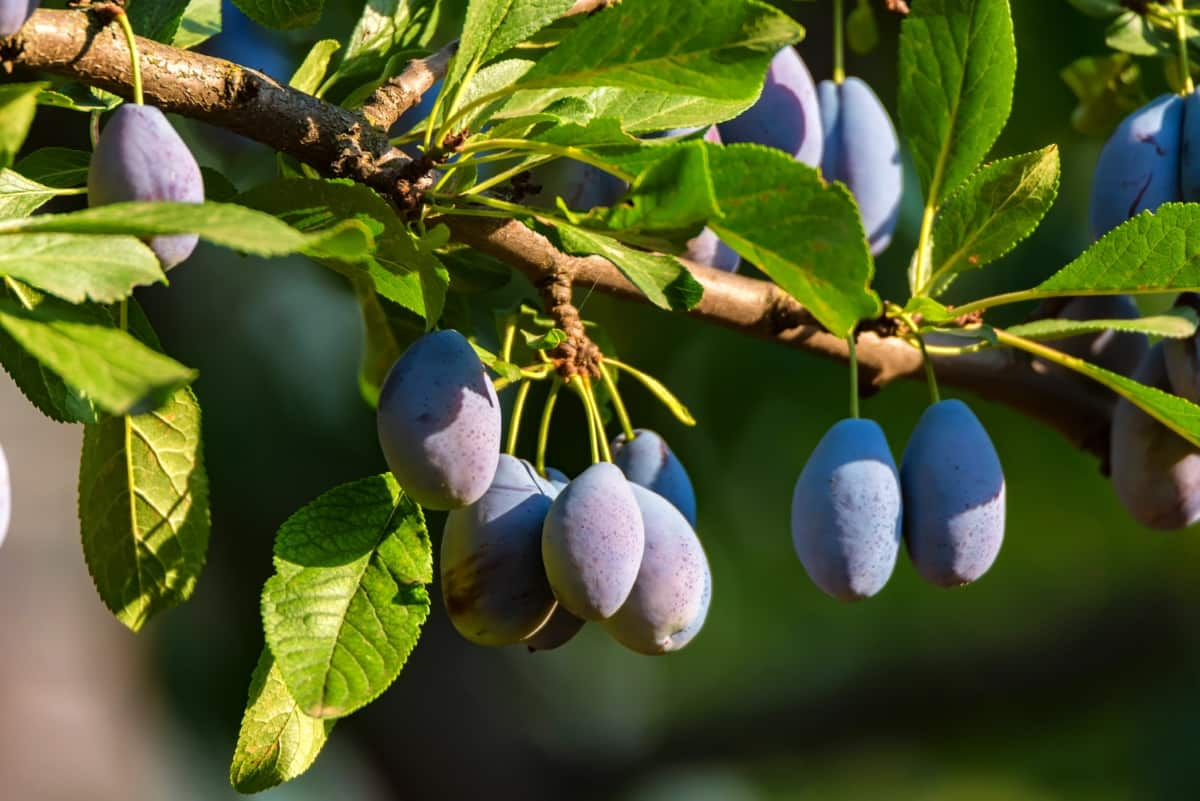Italian Plums are small to medium-sized Plums that have a distinctive oblong shape and deep purple skin. They are prized for their sweet, juicy flesh and rich flavor. In culinary circles, Italian Plums are highly regarded for their versatility. Gardeners appreciate Italian Plum trees not only for their delicious fruit but also for their ornamental value. The trees produce beautiful white blossoms in spring, adding beauty to any landscape.
Significance in Culinary and Gardening
Italian Plum trees hold great significance in both culinary and gardening pursuits. In the kitchen, these Plums are highly prized for their sweet and juicy flesh. Their vibrant flavor adds a delightful twist to jams, jellies, pies, and even savory dishes like roasted meats. In addition to their culinary value, Italian Plum trees also offer numerous benefits in the garden. These trees not only provide shade but also add aesthetic appeal with their delicate blossoms in springtime and colorful fruit throughout summer.

Italian Plum Trees
Varieties of Italian Plum Trees
Popular Italian Plum Cultivars
One of the most widely grown Italian Plum varieties is the ‘Stanley.’ This cultivar produces large, oval-shaped Plums with dark purple skin and sweet yellow flesh. Another variety is the ‘Santa Rosa’ Plum. This cultivar features medium-sized fruit with red skin and amber-colored flesh. If you’re looking for a smaller-sized Plum, consider planting the ‘Methley’ variety. These Plums have bright red skin and deep red flesh that is exceptionally sweet and juicy.
Characteristics of Different Varieties
One popular variety is the ‘Stanley’ Plum. Known for its purple skin and sweet flesh, this cultivar is perfect for eating fresh or using in jams and preserves. Another well-loved variety is the ‘Italian Prune.’ This Plum features a distinct dark purple skin with a greenish-blue bloom. Its juicy flesh has a sweet-tart flavor, making it ideal for both cooking and eating fresh. The Italian Prune tree is also known for its high productivity, making it a favorite among home gardeners.
Choosing the Right Variety
Factors to Consider
First and foremost, consider the climate in which you live. Italian Plum trees thrive in temperate climates with mild winters and warm summers. They require a certain number of chilling hours during winter to ensure proper fruit development. The soil composition is another crucial factor to consider. Italian Plums prefer well-draining soil that is rich in organic matter. Next, evaluate the available space in your garden.
Climate and Soil Preferences
Italian Plum trees thrive in a variety of climates, but they do have specific preferences when it comes to temperature and growing conditions. They naturally prefer a mild climate with warm summers and cool winters. However, they can also adapt well to colder regions if the winter temperatures don’t drop too low.
When it comes to Soil Requirements for Italian Plums, these are fairly adaptable. They can grow well in a wide variety of soil types, including loam, clay, and sandy soils. The most important factor is that the soil is well-drained to prevent waterlogged roots, which can lead to root rot. In terms of pH levels, Italian Plum trees prefer a pH between 6.0 and 7.0.
Planting Italian Plum Trees
Best Time to Plant
The best time to plant Italian Plum trees is in late winter or early spring. Before planting, make sure that all risk of frost has passed in your area. Plums are sensitive to cold temperatures, so it’s important not to expose young saplings to freezing conditions.
Step-By-Step Planting Process
Planting Italian Plum trees can be an exciting and rewarding experience. First, choose a suitable location for planting. Italian Plum trees prefer full sun, so find a spot in your garden that gets 6-8 hours of direct sunlight each day.
Next, prepare the soil and dig a hole that is sufficient to accommodate the tree’s roots without crowding them. The depth should be just deep enough so that the tree sits at ground level when planted. Gently spread out the roots and position the tree in the center of the hole. Backfill around the roots with soil, ensuring that there are no air pockets left behind. Tamp down gently on the soil to secure it around the roots.
Soil Preparation and Fertilization
Soil Requirements for Italian Plums
Italian Plums thrive in well-draining soil. Italian Plums prefer slightly acidic to neutral pH levels in the range of 6.0-7.0. Testing your soil’s pH level will help you determine if any adjustments need to be made using appropriate amendments such as sulfur or lime. In addition, Italian Plum trees require fertile soil that is rich in organic matter. Prior to planting, mix compost or well-rotted manure into the top layer of the soil to provide essential nutrients for optimal growth.
Fertilizing for Optimal Growth
When fertilizing Italian Plum trees, choose a balanced fertilizer specifically formulated for fruit trees. This will typically have equal ratios of nitrogen (N), phosphorus (P), and potassium (K). Nitrogen promotes leafy growth, phosphorus supports root development and flowering, while potassium enhances overall plant health. To determine how much fertilizer to apply, consider the age and size of your Italian Plum tree.
In case you missed it: How to Grow Plum Tree/Fruits from Seed to Harvest: Check How this Guide Helps Beginners

Watering and Irrigation Techniques
Watering Schedule for Young Trees
Young Plum trees should be watered deeply but infrequently. This means providing a thorough soaking twice a week rather than frequent light sprinklings. Deep watering encourages the deep roots, which in turn helps the tree withstand drought conditions.
Irrigation Methods for Mature Trees
One effective way to water mature Plum trees is through drip irrigation. This method involves placing hoses or tubing near the base of each tree, allowing water to slowly drip directly onto the roots. Drip irrigation conserves water by minimizing evaporation and runoff.
Another option for Irrigation for Italian Plum Trees is using sprinklers, which can provide a more widespread coverage of water. However, it’s important to avoid wetting the foliage excessively as this can promote disease development. When determining how much water your mature Plum trees need, consider factors such as weather conditions and soil moisture levels.
Pruning and Training
Pruning Techniques for Healthy Growth
Pruning Techniques for Plum Trees play a crucial role in maintaining the productivity of Italian Plum trees. By removing dead branches, you can prevent the spread of infections and ensure that resources are directed towards new growth.
It’s important to prune during the tree’s dormant season, in late winter or early spring. Start by removing any crossed or rubbing branches, as these can create wounds that invite pests and diseases. Additionally, thin out crowded areas to improve air circulation and light penetration within the canopy.
Training for Shape and Productivity
When it comes to Italian Plum trees, training them for shape and productivity is essential to ensure healthy growth and abundant fruit production. Proper training techniques not only help maintain a desired tree form but also encourage maximum yield.
To start, pruning plays a crucial role in shaping the tree. It’s important to remove any dead or diseased branches, as well as those that cross or rub against each other. This will promote good airflow and reduce the risk of fungal infections. During the early years of the tree’s life, it’s recommended to prune lightly to establish a strong framework of scaffold branches.
Pest and Disease Management
Common Pests and Diseases
One common pest that affects Italian Plum trees is the Plum curculio. These tiny beetles lay their eggs in developing fruits, causing them to become deformed and drop prematurely. To Control pests in Italian Plum Trees, regularly inspect your trees for symptoms of damage and consider using organic insecticides or traps.
Diseases that commonly affect Italian Plum trees include brown rot and bacterial spot. Brown rot causes fruit rotting and can spread quickly throughout the tree if not treated promptly with fungicides. Bacterial spot causes dark spots on leaves which eventually lead to defoliation; copper-based sprays are effective against this disease.
Organic and Chemical Control Strategies
Organic control methods focus on using natural substances or techniques to manage pests and diseases. This can include introducing beneficial insects that prey on harmful ones, such as ladybugs, for aphid control.
Another organic strategy is practicing good cultural care for Italian Plum trees. This involves maintaining healthy soil through proper fertilization, ensuring adequate water drainage, and keeping the area around the tree free of debris that may harbor pests or disease-causing organisms.
Chemical control methods include the use of synthetic pesticides or fungicides to combat pest infestations or fungal infections. These products are typically more potent than their organic counterparts but should be used with caution to minimize negative impacts on the beneficial insects.
Harvesting and Storing Italian Plums
Signs of Ripeness
One of the first signs of ripeness is a change in color. As the fruit matures, it will transition from green to shades of red, purple, or even yellow. Keep an eye on the Plum’s skin as it starts to develop a vibrant hue. Touch is another important sense when gauging ripeness. Ripe Italian Plums should have a slight give when gently squeezed. Avoid firm fruits as they may not be fully matured yet, while overly soft Plums may be overripe and mushy.
The fragrance also plays a role in identifying ripe plum. When perfectly ripe, Italian Plums emit a sweet aroma that fills the air around them. Take a moment to sniff each Plum before picking to ensure they have reached their peak fragrance.
Storage and Preservation Tips
When it comes to enjoying the deliciousness of Italian Plums throughout the year, proper storage and preservation techniques are key. It’s important to pick Plums at their peak of ripeness for optimal flavor and texture. Look for fruits that are soft to the touch but still firm. Avoid any blemishes or signs of decay.
In case you missed it: Plum Gardening For Beginners, How to Start

Once harvested, handle them gently to prevent bruising. You can store Plums at room temperature for a few days until they reach their desired level of ripeness. If you prefer them to be fully ripe, store them in a paper bag at room temperature for a day or two.
Propagation and Breeding
Propagating Italian Plum Trees
Propagating Italian Plum trees is an exciting endeavor for passionate gardeners and fruit tree enthusiasts. Grafting is the most common technique used to propagate Italian Plum trees. It involves joining a scion (a cutting from the desired variety) with a rootstock (the base onto which the scion will be grafted). This process allows the resulting tree to inherit desirable characteristics from both parents.
Rooting cuttings is another viable option for propagating Italian Plum trees. Select healthy, disease-free branches from your existing tree and remove all leaves except for two or three at the tip. Dip the cutting into rooting hormone powder, then plant it in a container with moistened soilless mix or perlite.
Breeding for Variety Improvement
One approach breeders take is selecting parent trees with desirable traits and crossing them to create offspring with a combination of those qualities. This can involve multiple generations of breeding and rigorous testing before a new variety is released to the market.
Breeders also consider factors such as adaptability to different climates and soils when developing new varieties. They strive for trees that can thrive in various regions without compromising their productivity or overall health. By creating robust cultivars suited for specific conditions, breeders ensure that Plum lovers across different areas can enjoy the fruits of their labor.
In case you missed it: Best Fertilizer for Plum Trees: Homemade, Organic, Compost, Natural, Liquid, When and How to Apply

Conclusion
Italian Plum trees are a wonderful addition to any garden. With their delicious fruit, beautiful blossoms, and relatively easy-care requirements, they offer both culinary delight and aesthetic appeal. Whether you’re an experienced gardener or a beginner, Italian Plum trees can be a great choice.
- How to Grow Hibiscus from Flower
- Plantation Ideas for Home Decoration: A Beginners Guide
- Flower Garden Designs and Layouts for Beginners
- Planting and Spacing Techniques in Papaya: A Beginner’s Guide
- Growing Gold: Essential Techniques for Planting Pineapples
- How to Make Kalanchoe Plant Bushy: Home Remedies and Solutions
- 11 Reasons Why Your Gardenia is Not Blooming: Home Remedies and Solutions
- Eco Elegance: The Guide to Designing a Drought-Tolerant Landscape
- Gardening on a Slope: Strategies for Hillside Landscaping